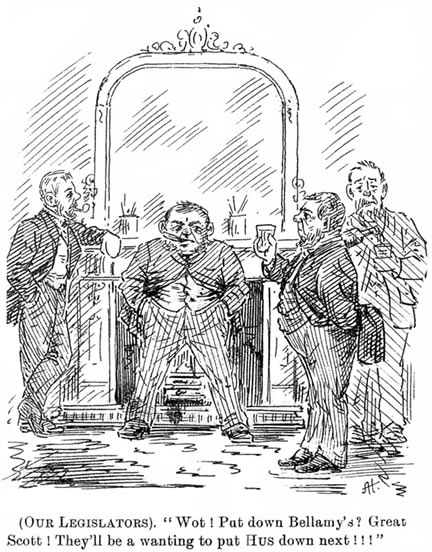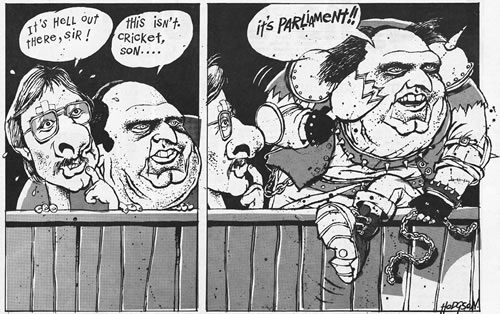Parliament in cartoons
For centuries, politics and Parliament have been the subject of public comment, satire and humour. Almost since the beginning, New Zealand's Parliament has been portrayed through the eyes of cartoonists, whose work appeared in newspapers and magazines. Cartoons poked fun at politicians and the political system, but humour was not always the main aim. There was frequently a sharp edge of irony or deliberate attempt to shock or provoke as well. Looking at cartoons tells us a lot about public opinion towards Parliament.
Today's cartoons are very different from those produced prior to the 1920s. Then, cartoons could be detailed and have long captions. They were run in weekly publications such as the Weekly News or in the weekend editions of daily papers, and so cartoonists had time to create detailed drawings. Many of the cartoonists used stock figures, often based on British models, as symbols. The British Lion, Britannia and John Bull were instantly recognisable to New Zealand readers as symbols for Britain.
After the 1920s, the daily papers picked up cartoons, and the style of drawing became less detailed. The old weeklies faded away after the Second World War, and since then, cartoons have mainly appeared in the dailies. From the 1970s, cartoonists set out more deliberately to offer social commentary and to provoke, as well as to entertain.

Choate, New Zealand Herald, 19 November 1951.
Observers of Parliament were attuned to anything that suggested inconsistency in policies. The New Zealand Herald's cartoonist recognised the irony of a new Speaker's chair being presented to Parliament in 1951 at a time when the buildings themselves were in disrepair; the fact that the chair was a gift from a visiting delegation from the British House of Commons seemed not to matter.

J.C. Hill, Christchurch Times, 21 February 1935.
No satirist could resist the temptation to draw the obvious conclusions of MPs talking a lot of 'hot air' from the stuffy state of the buildings and the poor ventilation in Parliament House during the 1930s. Cartoons frequently showed the buildings swathed in clouds of hot air, such as this one from J.C. Hill that appeared in the Christchurch Times in 1935.

NZ Observer and Free Lance, 12 July 1890.
Cartoonists and illustrators have a field day with distinctive physical characteristics of politicians. Weight, nose, hair style, beards, or any particular style of dress are played up. Vincent Pyke, MP for Otago in the 1880s, was always caricatured with an umbrella and a swollen red nose — a reference to his fondness for alcohol.

Alfred Domett, 1856. 'Scene, St Georges Bay - Time 1/2 past 2 a.m. (N.B. the house rose at Nine). "The honneblemember will resumehizzat."' Alexander Turnbull Library, A-090-023
Astute observers of Parliament were found inside the House as well as outside. In the 1850s and 1860s, MP Alfred Domett captured the foibles and habits of his fellow MPs, preserving them in a small sketchbook. His 1856 drawing shows one of his colleagues, flanked by two burly police officers, staggering home the worse for wear.

New Zealand Free Lance, 30 September 1911.
MPs' favourite subjects also appeared in cartoons. T.K. Sidey campaigned long and hard for the introduction of daylight saving in the early 1900s, and his New Zealand Local Time Bill became a hardy annual in the House. His persistence finally paid off in 1927 when the Summer Time Act introduced daylight saving for one year. It became permanent in 1929.

J.C. Hill, Auckland Star, 23 September 1933.
Anything new in the House came in for comment in the newspapers. When Elizabeth McCombs took her seat as the first woman in Parliament in 1933, there was much fussing about what she would wear. And of course, there were those who used the opportunity to suggest that the entire nature of Parliament would change. Here the Auckland Star's J.C. Hill has the male members in drag.

New Zealand Graphic, 16 September 1893.
MPs' so-called 'perks' were fair game. Salaries, travel allowances, meals at Bellamy's and many other things became the butt of humour, and a form of criticism when people thought that MPs had too much of a good thing. The New Zealand Graphic published this cartoon in 1893 as Parliament discussed banning booze from Bellamy's to keep faith with the growing temperance movement. Alcohol stayed in Bellamy's bar, but there were many MPs who were worried that they might miss out.

New Zealand Graphic, 5 August 1893.
Some members were notorious gasbags. Everyone tries to escape as Robert Stout pontificates.

Stuart Peterson, Free Lance, 2 October 1929.
The new standing orders of 1929 limited the speaking times of members.

Armed combat during question time under the Labour government. Trace Hodgson, New Zealand Listener, 8-14 September 1984.
Like salaries or 'perks', the behaviour of MPs in the chamber of the House has featured prominently in cartoons. The nineteenth-century politician Robert Stout had a reputation for being a windbag and droning on endlessly in convoluted and erudite speeches that drove his colleagues to distraction. The time that MPs had to speak got progressively shorter. The standing orders limited it to 30 minutes in 1894, and over the course of the twentieth century, MPs had less and less time to speak — just five to ten minutes from the mid 1990s. But of course, formal speeches are just one opportunity to speak in the House. Rightly or wrongly, question time has dominated the public perception of the House in action from the 1970s, and cartoonists were adept at highlighting its tempestuous nature.

Tom Scott, Evening Post, 21 October 1992.
There was a sharp edge to the cartoons that touched on public attitudes towards politics and politicians, especially as cartoonists themselves sought to offer a social commentary in their work. Through the 1980s a string of opinion polls suggested that the public's trust in politicians sometimes ranked about as high as that in used car sellers. Evening Post cartoonist Tom Scott, a former member of the press gallery, captured the public mood through this period. A fire during the refurbishment of Parliament Buildings in 1992 provoked this observation.